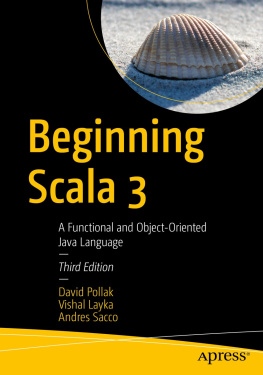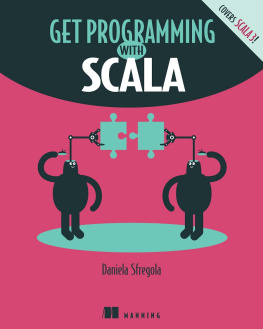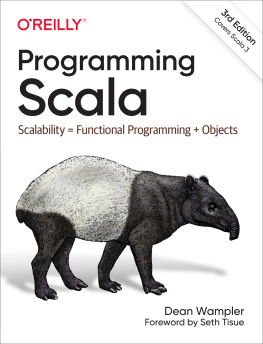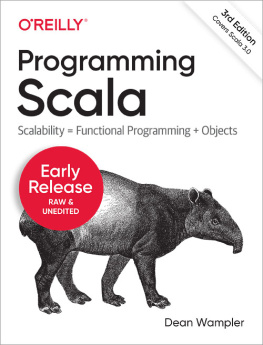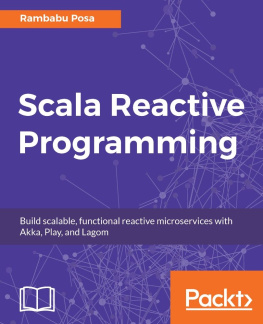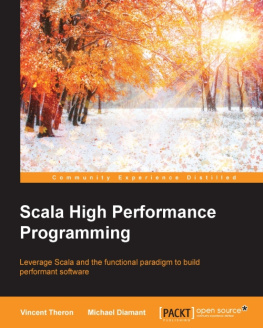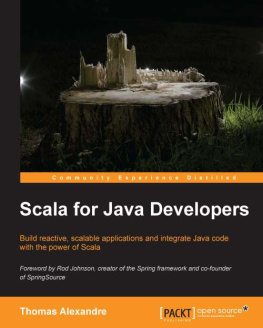William Emma - Scala Programming: A comprehensive beginners guide to Scala , 2nd Edition
Here you can read online William Emma - Scala Programming: A comprehensive beginners guide to Scala , 2nd Edition full text of the book (entire story) in english for free. Download pdf and epub, get meaning, cover and reviews about this ebook. year: 2021, genre: Home and family. Description of the work, (preface) as well as reviews are available. Best literature library LitArk.com created for fans of good reading and offers a wide selection of genres:
Romance novel
Science fiction
Adventure
Detective
Science
History
Home and family
Prose
Art
Politics
Computer
Non-fiction
Religion
Business
Children
Humor
Choose a favorite category and find really read worthwhile books. Enjoy immersion in the world of imagination, feel the emotions of the characters or learn something new for yourself, make an fascinating discovery.

- Book:Scala Programming: A comprehensive beginners guide to Scala , 2nd Edition
- Author:
- Genre:
- Year:2021
- Rating:5 / 5
- Favourites:Add to favourites
- Your mark:
- 100
- 1
- 2
- 3
- 4
- 5
Scala Programming: A comprehensive beginners guide to Scala , 2nd Edition: summary, description and annotation
We offer to read an annotation, description, summary or preface (depends on what the author of the book "Scala Programming: A comprehensive beginners guide to Scala , 2nd Edition" wrote himself). If you haven't found the necessary information about the book — write in the comments, we will try to find it.
William Emma: author's other books
Who wrote Scala Programming: A comprehensive beginners guide to Scala , 2nd Edition? Find out the surname, the name of the author of the book and a list of all author's works by series.
Scala Programming: A comprehensive beginners guide to Scala , 2nd Edition — read online for free the complete book (whole text) full work
Below is the text of the book, divided by pages. System saving the place of the last page read, allows you to conveniently read the book "Scala Programming: A comprehensive beginners guide to Scala , 2nd Edition" online for free, without having to search again every time where you left off. Put a bookmark, and you can go to the page where you finished reading at any time.
Font size:
Interval:
Bookmark:
Table of Contents Preface 1. Introduction 1.1 What managers should know about Scala 1.2 Java Scala integration 1.3 About this book 1.4 Typographical and other conventions 2 Setting up the work environment 2.1 The Scala shell and the command line 2.1.1 The Scala interpreter 2.1.2 The Scala (de) compilers 2.1.3 The documentation generator 2.2 Build tools 2.2.1 The Maven Scala plugin 2.2.2 Simple Build Tool 2.3 IDE support 2.3.1 Eclipse 2.3.2 NetBeans 2.3.3 IntelliJ IDEA 3 basics 3.1 A little bit of syntax 3.2 Imperative programming 3.3 An executable program 3.4 Annotations 4 Pure object orientation 4.1 Classes and Objects 4.1.1 Fields and methods 4.1.2 What else classes can contain 4.1.3 Constructors 4.1.4 Enumerations 4.1.5 Inheritance and subtyping 4.1.6 Abstract classes 4.2 Code organization 4.2.1 Packages 4.2.2 Package Objects 4.2.3 Imports 4.3 traits 4.3.1 RichInterfaces 4.3.2 Stackable modifications 4.4 Implicits and Rich wrappers 5 Functional programming 5.1 LazyEvaluation 5.2 Functions and recursions 5.3 Higher order functions 5.4 Case classes and pattern matching 5.4.1 Case classes 5.4.2 Sealed classes 5.4.3 Partial functions 5.4.4 Variable names for (partial) patterns 5.4.5 ExceptionHandling 5.4.6 Extractors 5.4.7 Pattern matching with regular expressions 5.5 Currying's own control structures 5.6 For expressions 5.7 Type system 5.7.1 Standard types 5.7.2 Parametric Polymorphism and Variance 5.7.3 Upper and Lower Bounds 5.7.4 Views and ViewBounds 5.7.5 ContextBounds 5.7.6 Arrays and @ specialized 5.7.7 GeneralizedTypeConstraints 5.7.8 Self-type annotation 5.7.9 Structural and existential types 6 The Scala Standard Library 6.1 Overview and the Predef Object 6.2 The Collection Framework 6.3 Scala and XML 6.4 Combining parsers 6.5 A little bit of GUI 7 Actors - Concurrency and Multicore Programming 7.1 One thread is one Actor 7.2 Receive and react 7.3 Demons and Reactors 7.4 Scheduler 7.5 RemoteActors 8 Software Quality - Documenting and Testing 8.1 Scaladoc 8.2 ScalaCheck. 8.2.1 Basics. 8.2.2 Generators. 8.2.3 Automated testing with SBT 8.3 ScalaTest 8.3.1 ScalaTestundJUnit 8.3.2 ScalaTestundTestNG 8.3.3 ScalaTestundBDD 8.3.4 Functional, integration and acceptance tests 8.3.5 DieFunSuite 8.4 Specs 8.4.1 A Specs specification 8.4.2 Matchers 8.4.3 MockswithMockito 8.4.4 LiterateSpecifications 9 Web programming with the lift 9.1 Quick start with lift 9.2 Bootstrapping 9.3 Rendering templates and snippets 9.4 User management and SiteMap 9.5 Persistence 9.6 Implementation of the snippets 10 Lightweight web programming with Scalatra 10.1 Quick start with Scalatra 10.2 The Final Grade Calculator 11 Akka Actors and SoftwareTransactionalMemory 11.1 Quick start with battery 11.2 The MovieStore 11.3 User and Session Management Preface Scala: A programming language that uniquely supports object-oriented Programming merges with the functional that is preparing to move Java from To throne and to program with that is really fun. In the summer semester of 2010, in addition to Haskell, I also taught Scala for the reading Advanced Functional Programming and many I have had good experiences.
I saw how my students medium functional concepts with Scala could be transferred very well to the JVM. ten. From the 2010/11 winter semester, I started using Scala instead of Java for the Use programming training of the freshman students. In Scala there arele things have been implemented in a simpler and cleaner way. For example, the Printout println ("Hello World") all by itself in a file as a script or type directly into the interactive Scala interpreter. In Scala you can Let's stay so close to Java at first that a later switch is hardly possible Likely to cause problems .
That I also distributed Scala for programming Discussing systems goes without saying thanks to the actors and akka. With this book I would like to bring you closer to everything Scala has to offer, in which, in addition to the programming language itself, I also give you the essentials I will introduce tools and frameworks. My warmest thanks go to everyone who made this book possible and to me in this one Supported the project: Above all my family. Important discussions and Patrick Baumgartner, Jrgen Dubau, Christoph Schmidt, Heiko Seeberger and Bernd Weber contributed. Thanks a lot for this. For the good I thank Margarete on behalf of the cooperation with the Hanser Verlag Metzger and Irene Weilhart.
Chapter 1 introduction Another new programming language, although: Scala is no longer like that New. The development began in 2001 at the cole polytechnique fdrale de La- sanne (EPFL) in Switzerland by a team led by Professor Martin Odersky. The first release was published in 2003. Version 2.0 followed in 2006 In 2010, while this book is being written, version 2.8 will be released. which, according to Odersky, should actually be 3.0 . 1995 he started with Phi- lip Wadler with the development of the functional programming language Pizza , which can be translated into bytecode for the Java Virtual Machine (JVM). 1995 he started with Phi- lip Wadler with the development of the functional programming language Pizza , which can be translated into bytecode for the Java Virtual Machine (JVM).
These Work led to GJ 4 and finally to the new javac compiler and the one with Java 5 introduced Java Generics . When Odersky came to EPFL in 1999, he shifted his focus a little. He had still the goal of object-oriented and functional programming tooconnect, but no longer wanted to be burdened with the restrictions of Java. After developing the programming language Funnel , he took on additional goals the practicality and interoperability with standard platforms and designed Scala . Scala is a hybrid language that uniquely combines features of objective connects entertaining and functional programming languages. Scala design goal is a concise, elegant and type-safe programming.
Scala isn't just inBytecode compiled for the JVM, any Java code can also be extracted directly Use the Scala and vice versa. Scala is a purely object-oriented programming language. That means, in Scala everythe value of an object. Scala uses a concept of classes and traits. With traits Rich interfaces can be implemented, because traits can already be implemented mentions included. Classes are extended through inheritance, traits are mixed into a class or an object.
So as not to get into typical problems running with multiple inheritance, traits are linearized. Whether Scala may call itself a functional programming language has been shortened on the web. lich first discussed in detail. Odersky finally refers to Scala in [Ode10a]as post-functional language. What is certain is that Scala has a number has features that are either attributable to functional programming or come from their environment. th are treated. th are treated.
This means, for example, that a function can ment or result of another function , functions can be in lists and functions can be nested within one another. In addition, Scala also supports features such as Pattern Matching and Cur- rysing . In contrast to many modern and trendy programming languages, Sca- la statically typed. That is, the type of all expressions becomes compile-time checked and not at runtime, as is the case with dynamically typed languages the case is. After a large number of programming errors type errors, we believe that static typing is generally preferable. to draw.
The main disadvantage, namely the need to have types everywheremust be specified is countered in Scala with a type inference mechanism.net. This means that it is not necessary to specify types in most places. At the When translating, the type is then inferred and it is checked whether everything fits together. Scala has a very sophisticated type system that, in addition to generic classes and polymorphic methods also include variance annotations, upper and lower bounds and much more. Another feature of Scala, which by the way stands for Scalable Language, is the easy expandability. Scala is therefore predestined for the creation of do- main Specific Languages (DSLs).
Next pageFont size:
Interval:
Bookmark:
Similar books «Scala Programming: A comprehensive beginners guide to Scala , 2nd Edition»
Look at similar books to Scala Programming: A comprehensive beginners guide to Scala , 2nd Edition. We have selected literature similar in name and meaning in the hope of providing readers with more options to find new, interesting, not yet read works.
Discussion, reviews of the book Scala Programming: A comprehensive beginners guide to Scala , 2nd Edition and just readers' own opinions. Leave your comments, write what you think about the work, its meaning or the main characters. Specify what exactly you liked and what you didn't like, and why you think so.

